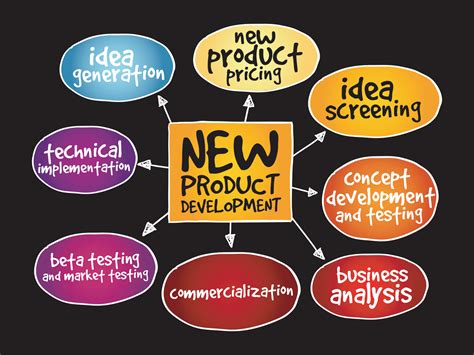Are you a budding entrepreneur or aspiring product manager looking to learn the ropes of product development and management? Look no further than the comprehensive programs offered at universities across the United States. In this blog post, we will delve into the world of product development and management, exploring the key concepts, phases, and strategies essential for bringing a product from concept to market.
From understanding the basics of product development to the integration of marketing principles and the importance of market research, we will cover it all. We will also discuss the tools, techniques, and technology that can be leveraged to ensure effective product development. Additionally, we will explore collaborative strategies for product development teams and shed light on how to overcome the challenges that often arise in this process.
But that’s not all – we will also share success stories and case studies that exemplify the journey from concept to market, inspiring and guiding you on your own product development and management path. So, join us as we embark on this insightful and educational journey into the world of product development and management programs at US universities.
Table of Contents
Introduction to Product Development and Management Programs
Product development and management programs are essential for businesses looking to innovate and stay ahead of the competition. These programs encompass the processes and strategies involved in bringing a new product to market and managing its lifecycle. They are designed to help organizations effectively plan, develop, launch, and manage products to meet consumer needs and achieve business objectives.
Product development and management programs are multidisciplinary, drawing from areas such as marketing, engineering, design, and innovation. They involve a combination of strategic planning, market research, design and development, testing, and commercialization. These programs are crucial for companies seeking to create competitive advantages through product innovation and differentiation.
By understanding the fundamentals of product development and management, businesses can enhance their ability to identify market opportunities, conceptualize and design new products, and successfully bring them to market. They can also improve their capabilities to manage existing product portfolios, optimize product performance, and make strategic decisions for product investments and development priorities.
Overall, product development and management programs are vital for organizations striving to drive growth, increase profitability, and build sustainable success in a rapidly evolving marketplace.
Understanding the Concept of Product Development
Product development is the process of creating new products or improving existing ones to meet the needs of consumers. It involves a series of steps from ideation to commercialization, and requires a multidisciplinary approach involving marketing, design, engineering, and manufacturing.
Understanding the concept of product development involves grasping the complexities of identifying market opportunities, conducting research, conceptualizing ideas, designing prototypes, testing, and finally launching the product. It requires a deep understanding of consumer behavior, market trends, and technological advancements.
Product development also encompasses the process of continuous improvement and innovation to stay ahead of the competition. It involves analyzing feedback, exploring new technologies, and adapting to changing consumer preferences.
Overall, understanding the concept of product development is crucial for businesses looking to stay competitive, innovate, and meet the ever-changing needs of consumers.
Exploring the Key Phases of Product Development
Product development is a crucial process in bringing a new product to market. It involves several key phases that are essential for the success of the product. The first phase is the ideation phase, where the initial concept for the product is developed. This is followed by the research phase, where market research and competitor analysis are conducted to assess the viability of the product idea.
Once the research phase is completed, the design phase begins, where the product is designed and engineered. This is a critical phase as it lays the foundation for the final product. The next phase is the testing phase, where the product is tested for quality, functionality, and user experience.
After the testing phase, the launch phase takes place, where the product is introduced to the market and made available to customers. This phase involves marketing, distribution, and sales strategies to ensure a successful launch.
Finally, the post-launch phase involves gathering feedback from customers, analyzing sales data, and making any necessary adjustments to the product based on the market response.
Importance of Market Research in Product Development
Market research plays a crucial role in the success of product development. It helps in understanding the needs and preferences of the target audience, and provides valuable insights into market trends and consumer behavior. By conducting thorough market research, businesses can make informed decisions about the features, design, and pricing of their products, ultimately leading to higher customer satisfaction and increased sales.
One of the key benefits of market research in product development is that it minimizes the risk of failure. By gathering data on competitors, consumer demand, and market gaps, companies can identify opportunities and potential challenges before investing time and resources into product development. This proactive approach allows businesses to make adjustments and improvements to their products, increasing the likelihood of a successful launch.
Furthermore, market research helps in identifying the unique selling points (USPs) of a product. By understanding the specific needs and preferences of the target market, businesses can tailor their products to stand out in a crowded marketplace. This competitive advantage is crucial for product success, as it allows companies to differentiate themselves and attract loyal customers.
In conclusion, market research is a fundamental aspect of product development. It provides valuable insights, minimizes risk, and helps in creating products that meet the needs and preferences of the target audience. By leveraging market research, businesses can improve the success rate of their product launches and stay ahead in a competitive market.
Tools and Techniques for Effective Product Development
When it comes to product development, having the right tools and techniques can make all the difference. A successful product development process requires a combination of creativity, innovation, and effective project management. With the right tools and techniques in place, businesses can streamline their product development efforts and bring new ideas to market more efficiently.
One essential tool for effective product development is the use of project management software. This type of software allows teams to collaborate on ideas, track progress, and manage deadlines in a more organized manner. By utilizing project management software, teams can stay on track and ensure that all aspects of the product development process are being attended to.
Another important technique for product development is the concept of rapid prototyping. This involves creating quick, low-cost versions of a product in order to test its functionality and gather feedback from potential customers. By rapidly prototyping a product, businesses can identify potential issues early on and make necessary adjustments before investing significant time and resources.
Effective product development also requires the use of market research tools and techniques. This may include conducting surveys, interviews, and focus groups to gather insights from target consumers. By leveraging market research, businesses can gain a deeper understanding of customer needs and preferences, ultimately leading to the creation of more successful products.
Leveraging Technology in Product Development Initiatives
Technology plays a vital role in modern product development initiatives, driving innovation and efficiency in the process. With the rapid advancements in digital tools and software, businesses can now leverage various technologies to streamline their product development cycles and bring innovative products to market at a faster pace.
One of the key ways technology is leveraged in product development is through computer-aided design (CAD) software. CAD tools allow product designers and engineers to create detailed 3D models of their products, enabling them to visualize and test their designs before moving on to the production stage. This not only reduces the time and cost involved in iterating designs but also helps in ensuring the product meets the desired specifications.
Another important aspect of leveraging technology in product development is rapid prototyping tools such as 3D printing. These tools enable the quick and cost-effective production of physical prototypes, allowing product development teams to test and validate their designs early in the process, leading to faster iterations and ultimately, a better final product.
Furthermore, the use of collaboration software and project management tools have revolutionized the way product development teams work together. With the help of these tools, teams can easily collaborate, share ideas, and streamline communication, leading to improved coordination and productivity.
Collaborative Strategies for Product Development Teams
In today’s fast-paced and highly competitive business environment, product development teams are under immense pressure to innovate and deliver high-quality products to the market. Collaboration is key to the success of any product development team, as it brings together diverse expertise and perspectives to solve complex problems and drive innovation.
One collaborative strategy that has proven to be effective for product development teams is cross-functional collaboration. This involves bringing together individuals from different functions within the organization, such as marketing, engineering, and design, to work together on a project. By leveraging the unique skills and knowledge of each team member, cross-functional collaboration can lead to more well-rounded and innovative product solutions.
Another important collaborative strategy for product development teams is open communication and knowledge sharing. This involves creating a culture of openness and transparency within the team, where individuals are encouraged to share their ideas, feedback, and expertise. By fostering open communication, product development teams can tap into the collective intelligence of the group and drive better decision-making.
Furthermore, leveraging digital collaboration tools can also significantly enhance the effectiveness of product development teams. With the use of tools such as project management software, virtual whiteboards, and video conferencing, teams can collaborate seamlessly across different locations and time zones, leading to more efficient and streamlined product development processes.
Integration of Marketing Principles in Product Development
Integration of Marketing Principles in Product Development
When it comes to product development, integrating marketing principles into the process is crucial for success. By incorporating marketing strategies and tactics from the very beginning, businesses can ensure that their products are not only well-designed and functional, but also targeted towards the right audience and effectively promoted in the marketplace.
One of the key aspects of integrating marketing principles in product development is conducting thorough market research. This involves analyzing consumer behavior, identifying market trends, and understanding the needs and preferences of potential customers. By gaining insight into the market, businesses can tailor their product development efforts to meet the demands of their target audience, ultimately increasing the likelihood of product success.
In addition to market research, another important marketing principle to integrate into product development is branding. Establishing a strong brand identity for a new product is essential for differentiating it from competitors and creating a lasting impression on consumers. This involves developing a unique brand image, messaging, and positioning that effectively communicates the value and benefits of the product to potential customers.
Furthermore, effective marketing communication strategies should be incorporated throughout the product development process. From the initial stages of concept development to the final stages of product launch, businesses should consider how they will communicate the value and benefits of the product to consumers. This may include developing a comprehensive marketing plan, creating compelling advertising and promotional materials, and leveraging various channels to reach the target audience.
Overcoming Challenges in Product Development and Management
Product development and management is a complex and multi-faceted process that involves various challenges at every stage. One of the major challenges faced by product development teams is the lack of clear communication and collaboration among team members. This can lead to misunderstandings, delays, and a lack of alignment on project goals and objectives. Another challenge is the ever-changing market trends and consumer preferences, which can make it difficult to anticipate and meet the demands of the target audience.
In addition, managing costs and resources effectively is a constant challenge in product development. Balancing the need for innovation and quality with budgetary constraints can be a daunting task for many organizations. Finally, navigating the regulatory and compliance landscape can pose significant challenges, especially for companies operating in highly regulated industries such as healthcare and pharmaceuticals.
However, these challenges can be overcome with the right strategies and approaches. Implementing robust communication and collaboration tools, fostering a culture of open communication and transparency, and staying agile and adaptable in response to market changes can help address the challenges of communication, market trends, and resource management. Moreover, staying abreast of regulatory changes and partnering with experts in compliance can alleviate the challenges associated with legal and regulatory requirements.
Successful product development and management require a proactive approach to addressing challenges and leveraging them as opportunities for growth and improvement. By identifying and addressing these challenges head-on, organizations can navigate the complexities of product development and management more effectively, leading to greater success in bringing innovative products to market.
Success Stories and Case Studies: From Concept to Market
Success stories and case studies in product development and management offer valuable insights into the journey from concept to market. These real-life examples showcase the challenges, strategies, and triumphs of taking an idea and turning it into a successful product. By examining the experiences of others, we gain a deeper understanding of the complexities involved in bringing a product to market.
One notable success story in product development is the case of Apple’s iPhone. The concept of a touchscreen smartphone was revolutionary at the time, and Apple faced numerous challenges in bringing the product to market. From sourcing the right technology to navigating regulatory hurdles, the iPhone’s journey from concept to market was fraught with obstacles. However, through innovative design, strategic marketing, and relentless perseverance, Apple successfully launched the iPhone, forever changing the landscape of mobile technology.
Another compelling case study is the story of Airbnb, a company that redefined the hospitality industry. The concept of allowing individuals to rent out their homes to travelers presented a disruptive shift in the market. Airbnb encountered resistance from traditional hoteliers and regulatory obstacles in various cities. Yet, through clever branding, user-friendly technology, and a strong community-building strategy, Airbnb not only brought its concept to market but also reshaped the way people think about travel accommodation.
These success stories and case studies demonstrate the importance of perseverance, innovation, and strategic decision-making in product development. They provide inspiration for aspiring product developers and managers, as well as valuable lessons for navigating the challenges of bringing a concept to market.





